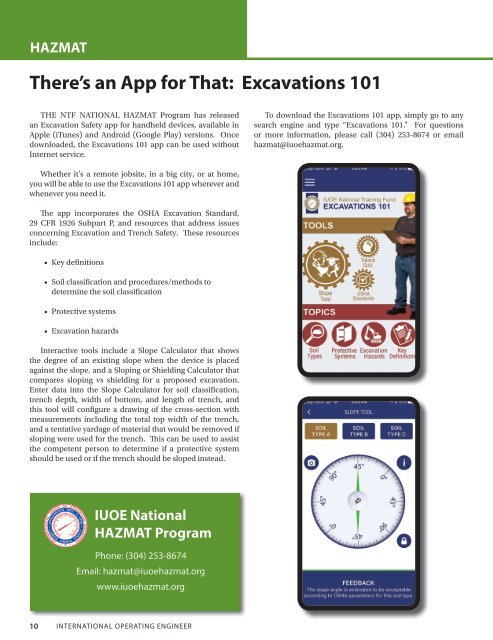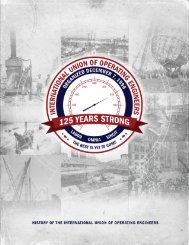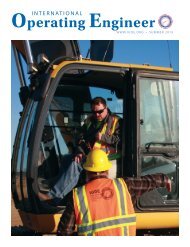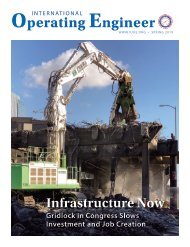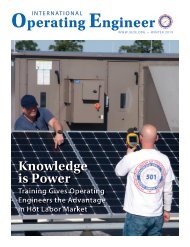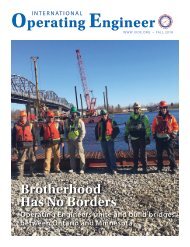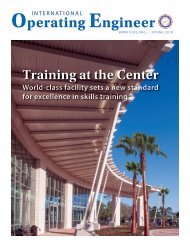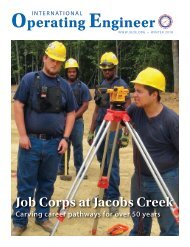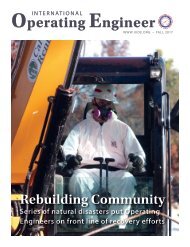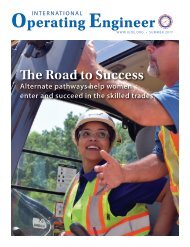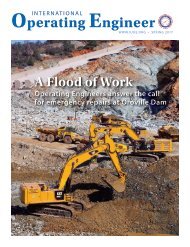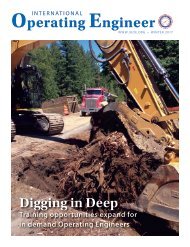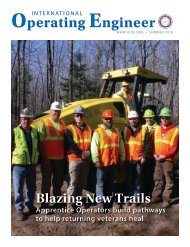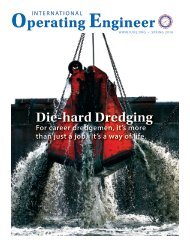International Operating Engineer - Summer 2018
The quarterly magazine of the International Union of Operating Engineers
The quarterly magazine of the International Union of Operating Engineers
Create successful ePaper yourself
Turn your PDF publications into a flip-book with our unique Google optimized e-Paper software.
HAZMAT<br />
There’s an App for That: Excavations 101<br />
Fatigue: Serious Safety Hazard in the Workplace<br />
THE NTF NATIONAL HAZMAT Program has released<br />
an Excavation Safety app for handheld devices, available in<br />
Apple (iTunes) and Android (Google Play) versions. Once<br />
downloaded, the Excavations 101 app can be used without<br />
Internet service.<br />
Whether it’s a remote jobsite, in a big city, or at home,<br />
you will be able to use the Excavations 101 app wherever and<br />
whenever you need it.<br />
The app incorporates the OSHA Excavation Standard,<br />
29 CFR 1926 Subpart P, and resources that address issues<br />
concerning Excavation and Trench Safety. These resources<br />
include:<br />
To download the Excavations 101 app, simply go to any<br />
search engine and type “Excavations 101.” For questions<br />
or more information, please call (304) 253-8674 or email<br />
hazmat@iuoehazmat.org.<br />
WORKER FATIGUE, often an overlooked hazard on the<br />
job site, can be a debilitating and deadly problem. So what<br />
exactly is fatigue? According to the National Safety Council,<br />
fatigue describes the feeling of tiredness, sleepiness, reduced<br />
energy and increased effort needed to perform tasks at a<br />
desired level.<br />
A 2012 guidance statement from the American College of<br />
Occupational and Environmental Medicine defines fatigue<br />
as the human body’s response to sleep deprivation or lengthy<br />
physical or mental hard work. One researcher notes that even<br />
dealing with other people can result in fatigue. Going to work<br />
and having poor social interactions with your coworkers can<br />
also be a cause of fatigued.<br />
• Sleep loss – less than 7 hours of sleep a day (43%)<br />
• No rest breaks – lack of short rest break during his/her<br />
shift (10%)<br />
• Quick shift returns – less than 12 hours off between<br />
shifts (14%)<br />
• Long commutes – commute of 30 minutes or more<br />
(31%)<br />
• Work overtime<br />
• Work many days in a row<br />
• Work where they are exposed to harsh environmental<br />
conditions<br />
• Work in noise and/or vibration<br />
• Perform heavy mental task loads for long periods of<br />
time<br />
• Key definitions<br />
• Soil classification and procedures/methods to<br />
determine the soil classification<br />
• Protective systems<br />
• Excavation hazards<br />
Interactive tools include a Slope Calculator that shows<br />
the degree of an existing slope when the device is placed<br />
against the slope, and a Sloping or Shielding Calculator that<br />
compares sloping vs shielding for a proposed excavation.<br />
Enter data into the Slope Calculator for soil classification,<br />
trench depth, width of bottom, and length of trench, and<br />
this tool will configure a drawing of the cross-section with<br />
measurements including the total top width of the trench,<br />
and a tentative yardage of material that would be removed if<br />
sloping were used for the trench. This can be used to assist<br />
the competent person to determine if a protective system<br />
should be used or if the trench should be sloped instead.<br />
Fatigue is cumulative and the result of inter-related<br />
factors. These factors include:<br />
• Sleep loss (lack of sleep)<br />
• Time of day<br />
• Time on task<br />
• Long work hours<br />
• Heavy work load<br />
• Environmental conditions<br />
• Medical conditions<br />
• Job demands<br />
• Shift work—works a non-daytime shift (difficult to get<br />
proper sleep in their time off)<br />
• Rotating shift work—worst for working against our own<br />
biology and putting ourselves at risk for sleep debt<br />
The effects of fatigue can include slower reaction<br />
time, more errors and decreased cognitive ability. David<br />
Lombardi, principal research scientist at the Center for<br />
Injury Epidemiology at the Liberty Mutual Research Institute<br />
for Safety in Hopkinton, MA, is quoted as saying, “Fatigue is<br />
an increasing health and safety problem in our lives due to<br />
the 24-hour society with decreasing emphasis on sleep.”<br />
Research has shown that fatigue can be equated to<br />
the same amount of impairment from alcohol intake and<br />
therefore the same amount of cause for concern.<br />
IUOE National<br />
HAZMAT Program<br />
Phone: (304) 253-8674<br />
Email: hazmat@iuoehazmat.org<br />
www.iuoehazmat.org<br />
Indicators that you work in an industry that may be at<br />
high/highest risk for fatigue include:*<br />
• Shift Work – non-day shift (17%)<br />
• Demanding jobs – work tasks that require sustained<br />
attention for long periods of time, or tasks that are<br />
monotonous, tasks that are repetitive or mentally<br />
demanding (81%)<br />
• Long shifts/Long work hours – as shift duration<br />
increases, safety risks also increase (21% work 10<br />
hours or more each shift)<br />
• Long weeks – weeks of 50 hours or more (22%)<br />
Now that the effects and indicators of fatigue on the job<br />
site has been covered, look in the next issue of <strong>International</strong><br />
<strong>Operating</strong> <strong>Engineer</strong> magazine for further discussion on<br />
different ways to handle fatigue and be safe on the job.<br />
*Fatigue in the Workplace: Causes & Consequences of Employee<br />
Fatigue; National Safety Council, 2017<br />
10<br />
INTERNATIONAL OPERATING ENGINEER<br />
SUMMER <strong>2018</strong> 11


